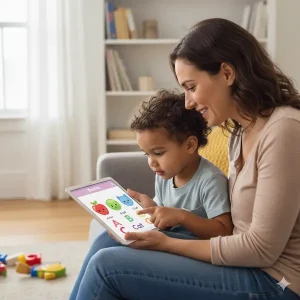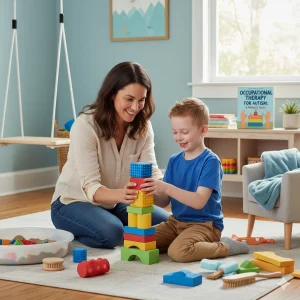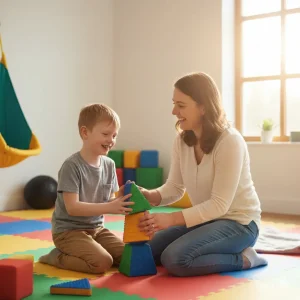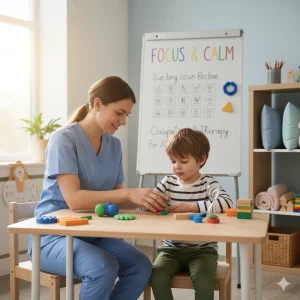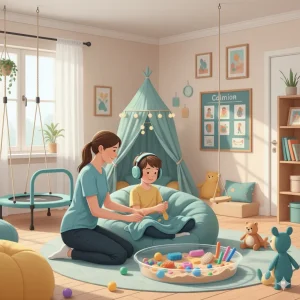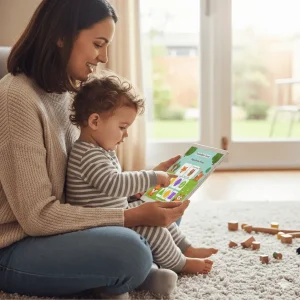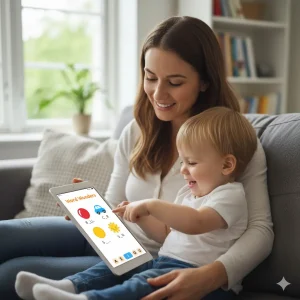How to Teach WH Questions at Home with Fun Activities
By Wellness Hub
Last Updated: July 22, 2025
“What?” “Where?” “Why?” — These are more than just curious questions toddlers ask. They’re essential building blocks for your child’s language and thinking skills. But for many children with speech delays, autism, or language processing challenges, answering WH questions can be a real struggle. The good news? You don’t need to be a speech therapist to help! With the right mix of fun WH question activities, at-home games, and interactive speech therapy apps, you can teach WH questions in playful, engaging ways that actually stick. Whether you’re a parent of a toddler just starting to talk or supporting a child with special needs, this guide will show you how to turn everyday moments—and a few smart apps—into powerful learning tools.
Why Do Some Children Struggle With WH Questions?
It’s completely normal for young children to ask lots of questions—“What’s that?” “Where are we going?” “Why is the sky blue?” But for many children between the ages of 2 and 8, especially those with speech delays or autism, learning to understand and answer WH questions can be confusing and frustrating.
So why does this happen?
Speech Delay and WH Questions
Children with a speech delay often have trouble forming words, putting together simple sentences, or understanding the words being spoken to them. Since WH questions (like what, where, who, why, when, and how) require both understanding language structure and coming up with the right answers, kids with speech delays may struggle on both ends. For example, when you ask “Where is your toy?”, a child with a speech delay might not grasp the question word “where” or may not know how to respond, even if they understand what you’re talking about.
These children need repetitive, clear, and supportive teaching, often through visuals, simple prompts, or structured WH question activities that help bridge the gap.
WH Questions for Autism
Children on the autism spectrum may have additional challenges. WH questions often involve social thinking, abstract language, or changes in routine—things that can be especially tough for kids with autism. A question like “Why are you sad?” requires a child to not only recognize their emotion but also explain the reason behind it—something that doesn’t come naturally to many autistic children.
In such cases, WH questions for autism need to be introduced gradually, using visuals, stories, and real-life scenarios. Many parents find success using speech therapy apps that offer picture-based WH question sets or story-driven examples to make learning more concrete.
Developmental Differences (2–8 Years)
Even among neurotypical children, WH questions don’t all develop at once. Most toddlers start with “what” and “where” questions around age 2, while more complex ones like “why” and “how” may not fully develop until age 4 or beyond. This is why it’s so important to provide targeted support between the ages of 2 and 8, when children’s speech and thinking skills are rapidly evolving.
For kids with language delays, additional practice, consistency, and structured tools—like flashcards, games, and interactive apps for WH questions—can make a huge difference.
When Should You Start Teaching WH Questions?
One of the most exciting parts of early childhood is when your little one starts asking questions. Those first curious words—“What’s that?” or “Where did it go?”—are more than just chatter. They’re signs that your child is beginning to think, communicate, and connect. Understanding when and how to teach WH questions at home can make a big difference, especially if you’re supporting a toddler with speech delay or early communication challenges.
Typical Developmental Timeline for WH Questions
Children don’t learn all WH questions at once. They develop in stages, building on each other over time:
- Around 2 years old: Many toddlers begin to understand and respond to “what” and “where” questions. You might hear them say “Ball!” when you ask “What is that?” or point to the table when you ask “Where’s your cup?”
- By age 3: Most children can answer “who” questions (e.g., “Who is that?”) and begin to experiment with “why” and “how”, although answers may still be short or inconsistent.
- By age 4 to 5: Children usually start answering more complex questions like “Why do we wear shoes?” or “How do you open the door?” These types of questions involve logical thinking, sequencing, and deeper understanding.
This means you can start introducing WH questions for toddlers as early as 18 to 24 months, using simple, everyday routines like mealtime, play, or storytime. The earlier you start, the more naturally your child will begin to pick up these important language skills.
Red Flags for WH Question Delays
While every child develops at their own pace, there are some signs that may suggest a need for early speech therapy or added support:
- Your child is over 2 years old and doesn’t respond to “what” or “where” questions.
- They rarely ask questions by age 3.
- They only respond with gestures or single words, even when you prompt them with simple WH questions.
- Your child struggles to stay engaged or seems confused when asked questions like “Who’s that?” or “Why are we brushing teeth?”
If you notice any of these signs, it’s a good idea to speak with a pediatric speech therapist. Early intervention can be incredibly effective—and there are many ways you can begin to teach WH questions at home, even before formal therapy begins.
Why Early WH Question Practice Matters
Practicing WH questions at home isn’t just about language—it builds social skills, attention, memory, and emotional understanding. Starting early helps children express themselves, understand others, and feel confident in everyday conversations.
Whether you’re reading books, playing games, or using interactive apps, the key is to make WH question learning fun, natural, and part of your daily routine.
Fun and Easy WH Question Activities at Home
You don’t need special training or expensive tools to help your child practice WH questions. With a little creativity, you can turn everyday routines into fun, learning-rich moments. Whether your child is just starting to talk or needs extra support due to a speech delay, these WH question activities make it easy to practice at home. They’re playful, effective, and designed to fit right into your daily life.
1. Picture Books and WH Question Prompts
Books are one of the best ways to introduce and practice WH questions. Choose simple, colorful picture books with clear illustrations and short sentences. As you read, pause and ask your child questions like:
- “What is the dog doing?”
- “Where is the bear going?”
- “Who is eating the apple?”
Don’t worry if your child doesn’t answer right away. You can model the response and gently encourage them to try. Repetition is key, especially for children who benefit from speech therapy at home.
Pro Tip: Keep a few favorite books in rotation and focus on one type of WH question at a time.
2. Flashcards and WH Question Packs
Flashcards are a classic and flexible tool for language learning. You can find or download WH question flashcards that show everyday scenes or actions with accompanying prompts. For example:
- A picture of a kitchen with the question “Where do we cook?”
- A picture of a crying baby with “Why is the baby sad?”
There are many printable resources available online—some free and some part of professional speech programs. You can print these at home and use them for quick practice sessions or even keep a small set in your bag for learning on the go.
3. Role-Playing and Pretend Play Ideas
Pretend play is one of the most fun WH question games you can do at home—and your child may not even realize they’re learning. Try setting up simple role-play scenarios such as:
- Let’s go shopping: Set up toy food, a basket, and a pretend cashier. Ask questions like:
- “What do we need to buy?”
- “Where is the apple?”
- “Who is paying?”
- Doctor’s clinic: Use a toy stethoscope or band-aids and ask:
- “Why is the teddy bear sick?”
- “How can we help him feel better?”
These games build language, social thinking, and problem-solving skills—all wrapped in play.
4. WH Question Scavenger Hunts Around the House
Turn your home into a learning playground with a WH question scavenger hunt. Create a list of clues or items using WH prompts, such as:
- “Where do we keep the shoes?”
- “What do we use to eat?”
- “Who sleeps in this bed?”
Give your child simple clues and let them explore the house to find the answers. This not only helps them practice question comprehension, but also builds memory, attention, and confidence.
Bonus: You can reuse the same questions and hide different items each time to keep things fresh and exciting.
Make It Routine, Make It Fun
The best part about these WH question activities is that they don’t require screens, and they fit right into everyday routines. Whether you’re reading a bedtime story, cooking dinner, or just cleaning up toys, there’s always a moment to ask a simple “what” or “where” and help your child grow their language skills.
Practicing speech therapy at home doesn’t have to feel like work. It can be playful, engaging, and filled with connection—just the way kids learn best.
Best Interactive Apps to Teach WH Questions
If you’re looking for a fun and effective way to support your child’s communication at home, interactive apps can be a game-changer. Especially for children with speech delays, autism, or early language challenges, the right tools can help make learning WH questions more visual, engaging, and accessible.
Instead of just repeating questions aloud, apps to teach WH questions often use colorful visuals, animated characters, and real-life scenarios to make learning stick. And the best part? You don’t need to be a therapist or educator to get started.
Here are some of the best features to look for in a good WH questions app—plus a recommended favorite trusted by thousands of parents and professionals.
BASICS App – Story-Based WH Question Learning Made Easy
One of the most powerful tools available today is the BASICS app, a therapist-designed learning app built especially for kids aged 2 to 8. It’s not just a general speech app—it has entire sections dedicated to WH questions that are perfect for home use or in therapy sessions.
Here’s what makes BASICS stand out as a WH questions speech therapy app:
Therapist-Designed Learning Levels
Every feature in the app is designed by a team of speech therapists, occupational therapists, and special educators. The app guides your child step-by-step through structured levels that match their current skill set—so they’re never overwhelmed, and always progressing.
Dedicated WH Question Sets
BASICS includes entire groups and activities focused on WH questions like:
- What is this?
- Where is it going?
- Who is doing it?
- Why is this happening?
These question sets are perfect for children with speech delay or kids with autism who need extra support with comprehension and expression.
The visuals are bright, animated, and interactive—so instead of just choosing an answer, your child can actually see it play out on screen.
Story-Based Adventures That Keep Kids Engaged
What sets BASICS apart from most other autism learning apps is the storytelling. Each chapter of learning is wrapped in a mini “adventure” designed to capture your child’s imagination.
For example:
- In one story, your child helps a mammoth eat fruit by answering WH questions correctly.
- In another, a dinosaur crosses a bridge with every completed set.
This kind of interactive WH question learning keeps children motivated while reinforcing key language skills in a natural, play-based way.
Real-Life Conversation Practice
Beyond multiple-choice answers, BASICS also includes sections that practice real-life communication, like greetings, turn-taking, and simple conversation exchanges using WH questions. This is especially useful for children on the autism spectrum, where understanding context is just as important as answering the question itself.
Why Use an App for Speech Delay or Autism?
- Apps offer visual support that many children with speech or processing delays need.
- They provide repetition without frustration—kids can replay questions as many times as they need.
- Apps like BASICS are portable and flexible—use them during quiet time, while traveling, or as part of your home therapy routine.
- They track progress, helping parents and therapists see what’s working and where the child needs more help.
Other Features to Look For in WH Questions Apps
When exploring options, here are a few key features to prioritize:
- Clear images and animations
- Voiceover support
- Gradual increase in difficulty
- Rewards or motivation system
- Flexibility to choose question type (e.g., just “what” or just “why”)
How to Use These Apps Effectively at Home
Downloading an app is just the beginning. To truly support your child’s language development, it’s important to use these tools consistently and purposefully. The great news is that you don’t need to be a therapist to get results. With a few simple strategies, you can turn any screen time into meaningful learning—especially when using the best speech therapy app designed for home use.
Whether you’re using an app to work on interactive WH questions or broader communication skills, here’s how to make the most of it.
1. Set a Routine – Even 10 Minutes a Day Helps
Children thrive on structure. Setting aside just 10 minutes a day for focused app time can lead to noticeable improvements—especially for children with speech delays or those on the autism spectrum.
Try adding app time to your daily schedule:
- After breakfast
- Before nap time
- As part of your evening wind-down
By keeping it short and consistent, you help your child stay engaged and avoid screen fatigue. A little progress each day builds big results over time.
2. Combine App Time with Real-Life Practice
Apps are a fantastic tool, but they work best when paired with offline activities. If your child just practiced “What is this?” on the app, use the same question during snack time or story time. Ask about their toys, food, or pictures in books.
For example:
- After an app activity on “Where” questions, you might ask, “Where is your shoe?” as you get ready to go out.
- After a “Who” question game, ask, “Who is knocking on the door?” when someone arrives.
This back-and-forth helps children apply what they learn in real life, making interactive WH questions more meaningful and functional.
3. Use Rewards and Visuals to Motivate Your Child
Most apps for speech therapy—like the BASICS App—are designed with children in mind. They often include built-in visual rewards, animations, or mini-stories that celebrate success. Use these features to your advantage!
- Praise your child when they complete a level.
- Let them replay their favorite adventure or animation.
- Set small goals (e.g., finish 3 sets today) and celebrate with a sticker, high-five, or extra playtime.
This turns learning into a positive experience and helps children feel proud of their efforts.
4. Switch Between Goal Mode and Library Mode (In the BASICS App)
If you’re using the BASICS App, take full advantage of its two flexible learning modes:
- Goal Mode offers a structured path guided by therapists. It’s great for parents who want a clear plan with steady progress—ideal if you’re new to speech therapy or your child needs a routine.
- Library Mode is perfect for more relaxed exploration or targeted practice. You can jump directly into any level, group, or set—especially useful during a therapy session or if your child wants to repeat a favorite activity.
The ability to switch between these modes allows you to adjust based on your child’s mood, attention span, or learning goals that day.
Real-Life Scenarios to Practice WH Questions
Helping your child learn WH questions doesn’t always require structured lessons or screen time. In fact, some of the best opportunities to practice happen right in your everyday routine. From breakfast to bedtime, you can weave in simple, playful WH question examples that boost your child’s understanding—and their confidence in communication.
These everyday moments make home speech therapy feel less like work and more like natural conversation.
During Meals: “What do you want to eat?”
Mealtimes are full of opportunities to engage with your child using WH questions:
- What do you want to eat?
- Where is your spoon?
- Why do we drink water?
- Who made this food?
Even a few minutes at the table can be turned into a language-rich moment. Let your child point, name, or even make silly guesses—every response helps build understanding.
During Play: “Where is your toy?”
Play is your child’s natural learning zone. As you join in, sprinkle in WH questions:
- Where is your toy hiding?
- What is the teddy bear doing?
- Who is driving the truck?
- Why is the doll sleeping?
Use pretend play scenarios to make the questions feel part of the story. For example, in a “doctor game,” ask:
“Why is the bunny sick?” or “What will we give him to feel better?”
These kinds of WH questions for daily routines teach cause and effect, sequencing, and object identification—all critical language skills.
During Storytime: “Who is in the picture?”
Books open the door to imagination and rich language practice. While reading, pause and ask:
- Who is in the picture?
- Where is the story happening?
- What is the girl doing?
- Why is he sad?
Even if your child isn’t ready to answer in full sentences, they might point, label, or repeat your words. This type of home speech therapy idea helps build listening comprehension and expressive language at the same time.
Bonus Tip: Re-read favorite books and vary your questions each time. Repetition with variation is powerful for children with speech or language delays.
On the Go: “When do we go to school?”
Outings, errands, or even car rides are great for casual language learning. Ask things like:
- When do we go to school?
- What do we need to buy?
- Where should we go next?
- Who do you want to visit?
These questions help kids connect language to real-life situations—an essential part of communication development.
Keep It Simple, Keep It Consistent
The key to practicing WH questions is consistency, not perfection. You don’t need long sessions or formal settings—just use what’s around you. The more naturally WH questions show up in your conversations, the more confident your child will become in understanding and using them.
Whether you’re preparing a snack, reading a book, or cleaning up toys, every moment is a chance to ask, connect, and grow.
WH Questions for Autism and Speech Delay: What to Keep in Mind
Children with autism or speech delays often need a different approach when it comes to understanding and answering WH questions. While many kids pick up “what,” “where,” and “why” through casual conversation, others may struggle with processing the language, understanding abstract concepts, or staying focused long enough to respond.
The good news? With the right tools and a bit of patience, you can make real progress. Whether you’re using speech delay apps, flashcards, or simple conversation during daily routines, the key is to keep things visual, repetitive, and predictable.
Use Visuals to Build Understanding
For children with autism or speech delays, spoken language alone often isn’t enough. They may not fully understand what “why” or “how” means without a visual cue. That’s why visuals—like pictures, icons, or animated scenes—are so important when teaching WH questions for autism.
Use:
- Picture cards showing actions or emotions
- Visual choice boards (e.g., “What do you want?” with images of food or toys)
- Apps that include WH question visuals, animations, and real-life examples
Many autism learning apps for toddlers offer image-based questions and answers that help children process information at their own pace. Seeing the answer play out visually helps them understand not just the word, but the meaning behind it.
Repetition and Predictability Build Confidence
Children on the autism spectrum often thrive on routine and repetition. So don’t worry about sounding like a broken record—repeating the same WH question in different settings helps it stick.
For example:
- “What is this?” can be asked during snack time, playtime, and while reading books.
- “Where is it?” can be practiced at home, at the park, or during clean-up time.
Using the same structure each time gives your child a sense of predictability and safety. When they know what to expect, they’re more likely to respond.
Leverage Apps and Tools That Support WH Questions
Today’s technology can be incredibly helpful when used with intention. Look for speech delay apps and autism learning apps that:
- Break questions down step-by-step
- Use real-life scenarios (e.g., “Why is the baby crying?” with animation)
- Let children select answers by tapping images or dragging choices
- Offer built-in story modeling, where characters show how to ask and answer WH questions
Apps like BASICS are designed specifically for young learners with developmental challenges. They combine visual learning, therapist-designed sets, and playful storytelling to gently guide your child through WH question practice.
Be Patient, Responsive, and Encouraging
Above all, remember: learning to answer WH questions takes time. Children with speech delays or autism may need extra processing time, simple sentence models, and plenty of encouragement.
- Give your child time to think before repeating or rephrasing the question.
- Model the answer clearly if they’re unsure (e.g., “What is that? It’s a car!”).
- Celebrate small wins—pointing, eye contact, even repeating part of the question is progress.
Your gentle, patient approach is just as important as the tools you use.
Free WH Question Resources for Parents
You don’t always need a fancy subscription or expensive materials to support your child’s speech and language development. In fact, many powerful tools are just a click away—and completely free! Whether your child is just beginning to explore “what” and “where” or needs extra help due to a speech delay or autism, these free speech therapy resources can make a real difference.
From printable worksheets to therapist-approved videos, here are some of the best no-cost resources to help you teach WH questions at home.
1. WH Question Flashcards
Flashcards are a tried-and-true way to teach and reinforce WH questions. They help your child visualize the question and stay focused on the task.
Look for WH question flashcards that include:
- Simple pictures (e.g., a girl eating, a boy holding a ball)
- Clear questions like:
- “What is he doing?”
- “Where is the dog?”
- “Who is eating?”
These cards can be printed, used on a tablet, or even cut and used in sorting games. Many websites and therapists offer free downloads, so you can start right away without needing to buy anything.
Pro Tip: Laminate your cards for durability, or keep them in a small box or zip pouch for on-the-go practice!
2. Printable Worksheets for WH Questions
Printable worksheets are perfect for slightly older kids or those who enjoy coloring, matching, or circling answers. These worksheets help reinforce comprehension and are great for quiet, focused time at home.
What you’ll find in a good WH question printable:
- Matching pictures to questions
- Fill-in-the-blank WH questions
- “Choose the correct answer” activities
- Cut-and-paste WH question scenes
These worksheets can be used during homeschooling, quiet time, or as part of your home speech therapy routine. You can print several pages at once and make your own WH questions binder for daily use.
3. Therapist-Recommended YouTube Channels and PDFs
Don’t underestimate the value of a good video! Many speech therapists share free WH question videos on YouTube, demonstrating how to ask, model, and practice WH questions in fun, engaging ways.
Look for channels that:
- Use visual aids and slow, clear speech
- Focus on “what,” “where,” “who,” “why,” and “how” questions
- Include real-life examples, puppets, or animations
Also, some therapy centers and websites offer free PDFs—including WH question charts, emotion check-ins, and daily language routines.
A few places to explore:
- YouTube channels run by certified speech-language pathologists (SLPs)
- Pinterest boards filled with parent-approved WH question resources
- Speech therapy clinic blogs that offer free PDF downloads
Conclusion
Every child learns at their own pace—and that’s okay! If your child struggles with WH questions, don’t worry. With a mix of speech therapy apps, daily routines, and fun WH question games, you can help them grow step by step. Try using an interactive app like BASICS—designed by experts—to teach WH questions in a playful, visual way. It’s great for kids with speech delay or autism, and easy for parents to use at home.
Frequently Asked Questions:
1. What are WH questions and why are they important for kids?
WH questions are questions that start with words like what, where, who, why, when, and how. They help kids understand the world, express themselves, and improve their thinking and language skills.
2. When should I start teaching WH questions to my child?
You can start teaching WH questions as early as 18 to 24 months. Start with simple “what” and “where” questions during daily routines or playtime.
3. Why does my child with speech delay struggle with WH questions?
Children with speech delay may have trouble understanding or answering WH questions because they are still learning how to use and process language. They often need more support and practice with simple, visual prompts.
4. How can I teach WH questions at home?
You can teach WH questions at home by using picture books, flashcards, role-playing games, or interactive speech therapy apps like BASICS. Just 10 minutes a day can help!
5. What are some fun WH question activities for kids?
Try scavenger hunts, pretend play like “Let’s go shopping,” or asking questions during meals and storytime. These WH question activities are fun and build language naturally.
6. Are there any free resources to help teach WH questions?
Yes! You can find free WH question flashcards, printable worksheets, and YouTube videos made by speech therapists. These are great free speech therapy resources for home use.
7. What is the best app to teach WH questions to kids?
The BASICS App is one of the best speech therapy apps for teaching WH questions. It includes story-based learning, visuals, and activities designed by therapists for kids with speech delays and autism.
8. How can I make learning WH questions easier for my child with autism?
Use visuals, repetition, and simple routines. Apps that show real-life situations and give picture choices, like BASICS, work well for teaching WH questions to children with autism.
9. Can a speech therapy app really help my child at home?
Yes! A good speech therapy app can provide structure, fun, and progress tracking. It helps children learn at their own pace and gives parents tools to support speech development at home.
10. What’s the difference between “Goal Mode” and “Library Mode” in the BASICS app?
Goal Mode gives you a step-by-step plan created by therapists. Library Mode lets you choose any activity freely. Both modes help teach WH questions in fun and easy ways.
About Wellness Hub – Empowering Every Child’s Development
Wellness Hub is a trusted digital platform that empowers parents, caregivers, and professionals with science-backed tools for childhood development. From online speech therapy to home therapy resources, we offer a holistic ecosystem for children facing speech delays, autism, ADHD, and other developmental challenges.
Rooted in evidence-based practices and delivered by certified experts, Wellness Hub bridges the gap between accessibility and quality care. Whether you need at-home speech strategies, developmental checklists, or interactive mobile apps like BASICS, we make early intervention affordable and family-friendly.
Start your journey today with expert guidance tailored to your child’s unique communication and learning needs—anytime, anywhere.
Book your Free Consultation Today
Parent/Caregiver Info:
Client’s Details:
* Error Message
